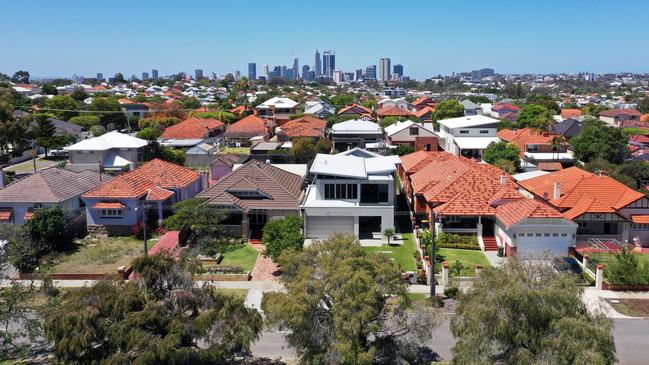The beauty and the power of 43: Why this time in life is important to property
Hidden deep within the 2021 Census data vaults lies a key figure that tells a powerful story. So what’s so special about the age of 43 and why is it so important for the property industry?

Looking at the key demographic trends which are coursing through our nation, it is clear that the age 43 is taking on a new significance. What once was considered middle age now signals the beginning of a new life cycle.
While the milestone may pass unremarked by many, it is of rising importance to policy makers, big companies and the property industry, all of which find themselves addressing an ageing population.
For the cohort of people hitting the birthday – and for those of us who find it in their past – working out what this means for the country will be critical.
Hidden deep within the data vaults of the 2021 Census there lies the figure telling a powerful story of the Australian people. It speaks to aspiration, to family, to the great arc of life. That figure is 43. It refers to the age at which peak full-time income earning capacity is reached in Australia.
At the 2016 Census the equivalent figure was 41. Peak income earning capacity is ageing two years in every five; it doesn’t quite keep up with the pace of human life. It’s a bit like Australia’s growing life expectancy which increases two months every 12 months.
Eternal life and forever peak income do not exist in the real world.
So what’s so special about the age of 43?
By the age of 43 most Australians have either “partnered-up” or are formally married. They have generally completed and are finished with the child-bearing stage of the life cycle. They have one, two or more kids who are either in, or are starting primary school.

Interestingly, other census questions show there is a peak in volunteering in the early 40s which aligns with the advent of primary-school-related activities like tuckshop duty or helping out with Little Athletics.
The significance of 43 should is not lost on the property industry. At this time in the life cycle primary caregivers usually return to the workforce. The late-30s and the early-40s is when many households are supported by two full-time income earners.
It is therefore a time in the life cycle to rethink housing arrangements.
It’s all very well to have a minimalist apartment in the fashionable inner city during the single or couple stage of the life cycle. But as soon as kids come along there’s a primal, almost visceral, need for a dwelling with three if not four bedrooms, two bathrooms, a front garden, a back yard (for a Labrador) and a Zoom room.
Builders of this kind of property should be gearing their marketing to a 43-year old couple with toddlers nearing the preschool stage of the life cycle. And the reason is simple enough.
Couples around the age of 43 have maximum spending power. From such a couple’s point of view it’s now or never to make the leap from minimalist (and rapidly becoming “kid messiest”) apartmentia to family friendly suburbia.
Or, better still, to make the leap to the lifestyle zone located just beyond the edge of town and which has been recently activated by the Covid-inspired work-from-home movement.
At age 43 there are 20 or more years left in the workforce to repay the (outrageous) mortgage. It’s time to buy that trophy property replete with all the accoutrement that is required for modern living.
Plus, at the back of this big-earning couple’s minds will be the confronting thought that their ‘trophy property’ must be capable of accommodating teenagers by the end of the 2020s.
Another option for some in the late 2020s is that peak-income-earning 43-year-old couples may choose to snap-up downsizing baby boomer homes in middle suburbia.
So, from a real estate sales point of view the 60-something downsizer’s primary market for housing are couples in their early- to mid-40s.
Although if this trend of later-peak-earning continues by the time the 2026 Census comes around 43 might become 45.

There is a catch to the significance of the age 43 to the property industry. Sadly the late-30s and the early-40s is also the time of peak separation and divorce.
Typically Australians marry late-20s or early-30s, have kids, revert to one full-time income (or one full-time and one part time income) for a few years, and then revert back to two full-time incomes around the age of 40. All this change can stress relationships at this time leading to, or exacerbating an existing case for, a separation.
In other words not all households follow the pathway to family-style housing by their mid-40s. Indeed separation and divorce are major drivers of modern household formation. The number of households in communities typically grows (marginally) between census years with nil population growth or even with falling population levels.
Separation and divorce can be a driver of this demand but so too can the desire for 20-somethings to live independently prior to commitment to marriage or to a de facto relationship.
The reason why this 43-figure is so important to the property industry (and to the business community more generally) is because it can predict an era of rising demand.
The Millennial generation born 1983-2001 (the definition varies) currently comprises six million Australians who will over the coming decade pass through the peak-income-earning stage of the life cycle.
This is a bit like a demographic alignment of celestial bodies: the Millennial moon is moving into a position of perfect alignment with the Peak-Income-Earning planet, thus amplifying demand for family style housing.
And for 40-something millennials unwilling to leave the inner city and/or who have not followed the pathway to traditional family formation, this group is likely to underpin a rising market for even more aspirational apartment living.
The peak income-earning stage in the life cycle for part-time workers at the 2021 Census was 41 up from 39 in 2016. Again this suggests that “peak-income” is drifting into the 40s, as households reach their peak spending potential technically between the ages of 41 and 43.
This is not only the time to buy a trophy property but also the time to buy and/or upgrade whitegoods and cars, to take family holidays (with kids clubs), to renegotiate housing loans and, ideally, to maximise allocations to superannuation.
However I suspect the years 41-43 are also sufficiently removed from the retirement horizon that retirement planning is rarely prioritised above more immediate ‘family’ needs.
There is another observation that is evident from the median income earning curve for full-time workers. After the age of 43 the (full-time worker) income curve gently subsides which suggests that there is a trade-off being made by workers between working hard and missing out on valuable family time.
After achieving and/or establishing the ‘forever’ family home there is less incentive to work long hours to deliver maximum income. Even so, the chart shows that maximum income to within 5 per cent of 43-peak extends between the ages of 37 and 51.
Here is a decade-and-a-half devoted to raising, supporting and funding a family. Of course raising a family extends across a much wider time frame however these years are clearly the core years, with 43 being the peak.

It is also possible that the age 43 peak income year reflects another observation about the Australian workforce. That beyond the age of 43 the scope for salary growth (within a business or government enterprise) diminishes.
On the one hand late-40-somethings may not be predisposed to trading off family time to pursue income growth. But on the other hand heads-of-departments may be ideally selected from the pool of rising talent in the late-30s and early-40s.
And there is a logic to selecting business leaders from the early-40s labour pool. At this time in the life cycle workers have yet to make their mark and so they might be quite predisposed to taking risks. Older workers may be more risk averse and more protective of their legacy.
In either case the point is made that this single figure, the age at which peak median income is reached for full-time workers in Australia, the age of 43, is an important number to watch at each census.
It sets the agenda for consumer spending and for housing demand: everything pivots around and/or spins off this technical midpoint in the Australian life cycle.
In fact surely 43 is one of the best, if not the best year in the life cycle.
It is far enough in advance of retirement that insufficient savings isn’t an everyday concern. Workers at this age are in contention not just for work but for appointment to the most senior positions. It’s barely halfway through life; there is no sense that time’s running out.
And then there’s the joy and the excitement of family formation, of buying and fitting out a new home. The kids have yet to morph into the troubled teenage years. And the great middle age metabolism shift has yet to set in.
The 2021 Census got this figure exactly right: 43 is arguably the best year in the Australian life cycle.
Bernard Salt is founder and executive director of The Demographics Group; data by Hari Hara Priya Kannan







The new 40 might be a lot closer in years than many would have us believe.